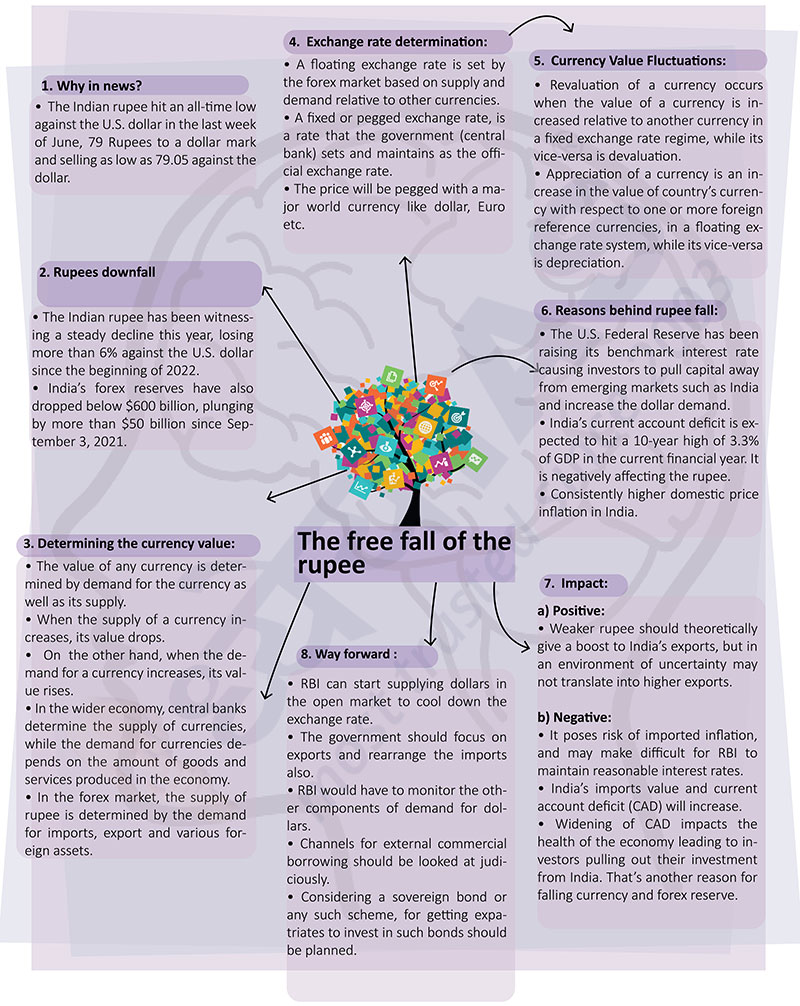Brain-booster
/
07 Aug 2022
Brain Booster for UPSC & State PCS Examination (Topic: The free fall of the rupee)

Why in news?
- The Indian rupee hit an all-time low against the U.S. dollar in the last
week of June, 79 Rupees to a dollar mark and selling as low as 79.05
against the dollar.
Rupees downfall
- The Indian rupee has been witnessing a steady decline this year, losing
more than 6% against the U.S. dollar since the beginning of 2022.
- India’s forex reserves have also dropped below $600 billion, plunging by
more than $50 billion since September 3, 2021.
Determining the currency value:
- The value of any currency is determined by demand for the currency as
well as its supply.
- When the supply of a currency increases, its value drops.
- On the other hand, when the demand for a currency increases, its value
rises.
- In the wider economy, central banks determine the supply of currencies,
while the demand for currencies depends on the amount of goods and services
produced in the economy.
- In the forex market, the supply of rupee is determined by the demand for
imports, export and various foreign assets.
Exchange rate determination:
- A floating exchange rate is set by the forex market based on supply and
demand relative to other currencies.
- A fixed or pegged exchange rate, is a rate that the government (central
bank) sets and maintains as the official exchange rate.
- The price will be pegged with a major world currency like dollar, Euro
etc.
Currency Value Fluctuations:
- Revaluation of a currency occurs when the value of a currency is
increased relative to another currency in a fixed exchange rate regime,
while its vice-versa is devaluation.
- Appreciation of a currency is an increase in the value of country’s
currency with respect to one or more foreign reference currencies, in a
floating exchange rate system, while its vice-versa is depreciation.
Reasons behind rupee fall:
- The U.S. Federal Reserve has been raising its benchmark interest rate
causing investors to pull capital away from emerging markets such as India
and increase the dollar demand.
- India’s current account deficit is expected to hit a 10-year high of
3.3% of GDP in the current financial year. It is negatively affecting the
rupee.
- Consistently higher domestic price inflation in India.
Impact:
a) Positive:
- Weaker rupee should theoretically give a boost to India’s exports, but
in an environment of uncertainty may not translate into higher exports.
b) Negative:
- It poses risk of imported inflation, and may make difficult for RBI to
maintain reasonable interest rates.
- India’s imports value and current account deficit (CAD) will increase.
- Widening of CAD impacts the health of the economy leading to investors
pulling out their investment from India. That’s another reason for falling
currency and forex reserve.
Way forward :
- RBI can start supplying dollars in the open market to cool down the
exchange rate.
- The government should focus on exports and rearrange the imports also.
- RBI would have to monitor the other components of demand for dollars.
- Channels for external commercial borrowing should be looked at
judiciously.
- Considering a sovereign bond or any such scheme, for getting expatriates
to invest in such bonds should be planned.







